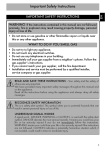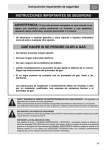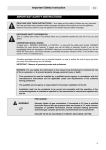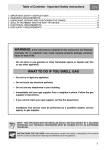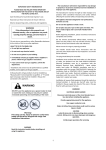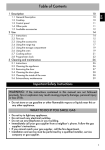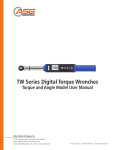Download Conversion Kit
Transcript
Important Safety Instructions IMPORTANT SAFETY INSTRUCTIONS WARNING: If the instructions contained in this manual are not followed precisely, fire or explosion may result causing property damage, personal injury or loss of life. - Do not store or use gasoline or other flammable vapors or liquids near this or any other appliance. WHAT TO DO IF YOU SMELL GAS • Do not try to light any appliance. • Do not touch any electrical switches. • Do not use any telephones in your building. • Immediately call your gas supplier from a neighbor’s phone. Follow the gas supplier’s instructions. • If you cannot reach your gas supplier, call the fire department. - Installation and service must be performed by a qualified installer, service company or gas supplier. READ AND SAVE THESE INSTRUCTIONS - Your safety and the safety of others are very important. We have provided many important safety messages throughout this manual and on the appliance. Read all the instructions before using the appliance and always obey all safety messages. RECOGNIZE SAFETY INFORMATION This is a safety alert symbol. This symbol alerts you to potential hazards that can result in severe personal injury or loss of life. UNDERSTAND SIGNAL WORDS A signal word - DANGER, WARNING or CAUTION - is used with the safety alert symbol. DANGER denotes the most serious hazards. It means you could lose your life or be seriously injured if you do not immediately follow the instructions. WARNING means you could lose your life or be seriously injured if the instructions are not followed. CAUTION indicates a potentially hazardous situation which, if not avoided, could result in minor to moderate injury. 3 Important Safety Instructions The safety messages will inform you of potential hazards, on how to avoid the risk of injury and what can occur if the instructions are not followed. IMPORTANT: Observe all governing codes and ordinances. WARNING: For your safety, the instructions contained in this manual must be followed to minimize the risk of fire or explosion and to prevent property damage, personal injury or loss of life. - This conversion kit must be installed by a qualified service agency in accordance with the manufacturer's instructions and all applicable codes and requirements of the authority having jurisdiction. - If the information in these instructions is not followed exactly, a fire, an explosion or production of carbon monoxide may result causing property damage, personal injury or loss of life. - The qualified service agency is responsible for the proper installation of this kit. The Installation is not proper and complete until the operation of the converted appliance is checked as specified in the manufacturer’s instructions supplied with the kit. Installation shall not be considered correct and complete until the operation of the converted appliance is checked as specified in the manufacturer's instructions supplied with this kit. FIRE HAZARD WARNING Securely tighten all gas connections. lf connected to LP, have a qualified technician ensure that the gas pressure does not exceed a 14” W.C.P. Examples of qualified technicians include licensed heating personnel, authorized gas company personnel and authorized service personnel. FAILURE TO DO SO CAN RESULT IN LOSS OF LIFE, EXPLOSION, OR FIRE. Caution: Before proceeding with the conversion, the gas supply must be shut off prior to disconnecting the electrical power. 4 Conversion Kit Check that the main gas supply line to the range is shut off and that the power supply cord is disconnected. 1) 2) Remove access cap “A” by using a screwdriver or a coin, turning the access cap counterclockwise. The gas pressure regulator has two settings which are indicated on two sides of the cap. Turn the cap and reinstall it in the regulator with "LP" visible from the outside of the regulator. Incoming line pressure upstream from the regulator must be 1” (2.5 cm) W.C.P. higher than the manifold pressure in order to check the regulator. Incoming line pressure to the regulator should be as follows for operation and checking the regulator setting: - NATURAL GAS: Set pressure to 4” W.C.P. Incoming line pressure of 3 1/2” - 10 1/2” W.C.P maximum; - LP GAS: Set pressure to 11” W.C.P. Incoming line pressure 8”- 13” W.C.P. maximum. The range must be isolated from the gas supply piping system by turning off the respective manual shutoff valve during any pressure testing of the gas supply piping system at test pressures equal to or greater than 1/2 psig (3.5 kPa). Replacing the rangetop's burners nozzles (This operation does not require primary air regulation). 1 Remove the grates and all the burner caps and heads; 2 Unscrew the burner nozzles with a 7 mm socket wrench; 3 Replace the nozzles according to the type of gas to be used and the description in paragraph 3.2 “Burner and nozzle characteristics table”. 4 Put the burners back in their correct position. 3) 5 Conversion Kit Replacing the oven's burners nozzles (This operation does not require primary air regulation). C24GGXU (23 15/16 ” - 608 mm) 1) Oven burner: Open the oven door and remove any accessories that are inside. 2) Lift up the oven surface and pull it outwards. 3) Loosen the screws A and B. 4) 4) Move away the lock that secures the thermocouple and igniter to the burner with screw A. 5) Slide the burner outwards until the nozzle is accessible. 6) Replace the nozzle using a 7mm socket wrench. 1) Broil burner: Open the oven door and remove any accessories that are inside. 2) Loosen the screw B. 3) Slide the burner outwards until the nozzle is accessible. 4) Replace the nozzle using a 7mm socket wrench. 6 Conversion Kit Replacing the oven's burners nozzles (This operation does not require primary air regulation). C36GGXU (35 3/4 ” - 908 mm) 1) Oven burner: Open the oven door and remove any accessories that are inside. 2) Unscrew the two fastening screws before removing the oven floor. 3) Lift the oven floor and slide it out. 5) 4) Unscrew the burner's fastening screw. 5) Remove the burner from its place by sliding it out and moving it to the side. (Make sure not to damage the thermocouple or the spark electrode during this operation). 7 Conversion Kit 6) Using a 7mm socket wrench replace the nozzle, installing the one that is appropriate for the type of gas to be used. Refer to the gas charts at point 5. 7) WARNING: The tightening torque of the nozzle must be equal to 4 Nm. After replacing the nozzle, put the burner back in its place. (Make sure not to damage the thermocouple or the spark electrode during this operation). 8) Screw in the burner's fastening screw. 9) Reposition the oven floor making sure to insert it correctly. The floor must be perfectly level. 10) Screw in the two fastening screws after having repositioned the oven floor. 8 Conversion Kit 1) Broil burner: Open the oven door and remove any accessories that are inside. 2) Unscrew the two fastening screws for the burner. 3) Remove the burner by sliding it from its place and reposition it as shown in the picture. (Make sure not to damage the thermocouples and the spark electrode). 4) Using a 13mm socket wrench replace the nozzle, installing the one that is appropriate for the type of gas to be used. Refer to the gas charts at point 5. 5) WARNING: The tightening torque of the nozzle must be equal to 4 Nm - 14.4 Ozf. Correctly reposition the burner in its place and screw in the two fastening screws. 9 Conversion Kit 6) To adjust the range for LP gas or to return to Natural Gas use, refer to the charts below. C24GGXU (23 15/16 ” - 608 mm) Natural gas Qt Injector Qr BTU Ø mm BTU Front Right 6200 1.20 1500 Front Left 6200 1.20 1500 Rear Left 3400 0.90 1200 0.80 1000 1.65 2000 Rear Right Inner Outer 14400 Oven 11500 1.60 3000 Broiler 11000 1.55 - Qt Injector Qr By-pass BTU Ø mm BTU mm Front Right 6200 0.72 1500 0.39 Front Left 6200 0.72 1500 0.39 Rear Left 3400 0.54 1200 0.33 0.46 1000 0.30 0.94 2000 0.60 LP Rear Right Inner Outer 14400 Oven 11500 0.94 3000 0.52 Broiler 11000 0.93 - - NOTE: Save the nozzles that were removed from the appliance along with these instructions for possible future use. 10 Conversion Kit C36GGXU (35 3/4 ” - 908 mm) Natural gas Qt Injector Qr BTU Ø mm BTU Front Right 6200 1.20 1500 Front Center 3400 0.90 1200 Front Left 6200 1.20 1500 Rear Left 3400 0.90 1200 0.80 1000 1.65 2000 Rear Center Inner Outer 14400 Rear Right 10000 1.52 2500 Oven 16900 2.15 4600 Broiler 16900 2.15 - Qt Injector Qr By-pass BTU Ø mm BTU mm Front Right 6200 0.72 1500 0.39 Front Center 3400 0.54 1200 0.33 Front Left 6200 0.72 1500 0.39 Rear Left 3400 0.54 1200 0.33 0.46 1000 0.30 0.94 2000 0.60 LP Rear Center Inner Outer 14400 Rear Right 10000 0.90 2500 0.45 Oven 16900 1.20 4600 0.68 Broiler 16900 1.20 - - NOTE: Save the nozzles that were removed from the appliance along with these instructions for possible future use. FIRE HAZARD WARNING Use a soapy solution to check that it is leak-tight. Never test for gas leaks with a match or other flames. Failure to follow this instruction can result in loss of life or fire 11 Conversion Kit 7) Follow these instructions to leak test the appliance: Use a brush and liquid detergent to test all gas connections for leaks. Bubbles around connections indicate a leak. If a leak appears, shut off the gas valve controls and adjust the connections. Then check the connections again. Remove all the detergent product from the range. Replace the parts on the burner and turn the knobs on the gas tap pins. NEVER TEST FOR GAS LEAKS WITH A MATCH OR OTHER FLAMES. 8) Check that the flame at the maximum flame position has a blue color. It should be clean and soft in character. No blowing or lifting of flame should occur. Occasional orange flashes are normal and reflect different elements in the air or gas. Minimum adjustment for Natural Gas Cooking Hob: Light the burner and turn the knob to the minimum position . Remove the gas tap knob and turn the adjustment screw at the side of the tap rod until the desired minimum flame is achieved. Refit the knob and verify that the burner flame is stable (when turning the knob rapidly from the maximum to the minimum position the flame must not go out). Repeat this operation on the remaining gas taps on the hob. 9) Oven: Light the burner and turn it to the maximum temperature for at least 10 minutes. Then, turn the knob to the minimum position (LOW). Remove the knob and, using a screwdriver, locate the adjustment screw alongside of the tap rod (as shown in the figure). Turn the adjustment screw until the desired minimum flame is achieved. Refit the knob and verify that the burner flame is stable (when turning the knob rapidly from the maximum to the minimum position the flame must not go out). Moreover, check that the flame does not go out when the door is being openend or closed. 10) Minimum adjustment for LP Gas Turn off the burners and unplug the appliance from the electrical power supply. For regulating the minimum with LP, the screws at the side of the tap rod must be turned clockwise all the way. Once the regulation has been completed, replace the seal on the by-passes using paint or similar materials. Follow the instructions given in point 9 to locate the adjustment screws. 11) Completely fill out the conversion label (part no. 92849A078) and attach it to the rear of the appliance. Do not cover any other labels with the conversion label. 12) At higher altitudes, no further adjustments are necessary. Derating the burners is also unnecessary. NATURAL GAS: To convert back to Natural Gas: Follow steps 1 through 9 and replace the nozzles in the order in which they were removed. 12










